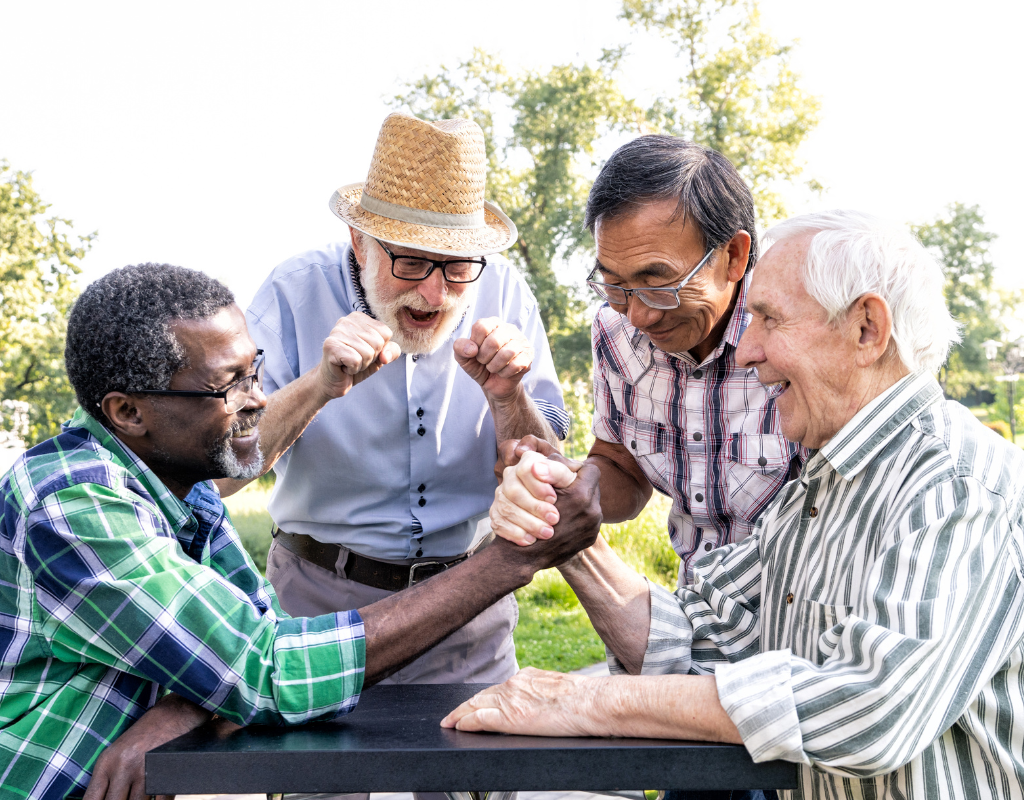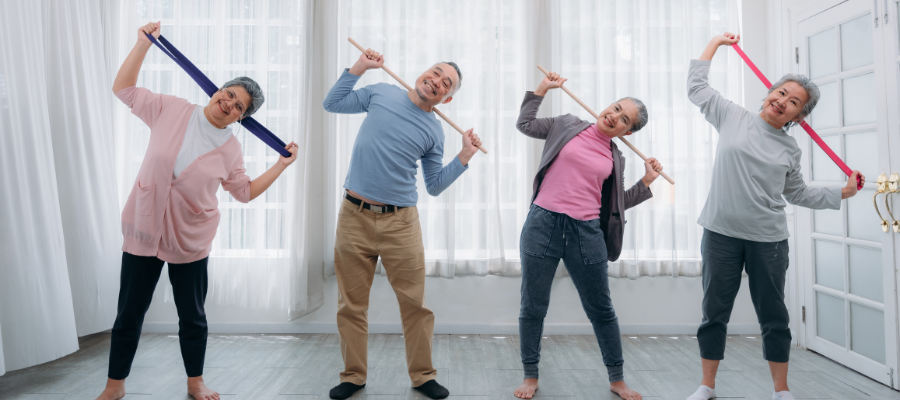You’ve probably heard that exercise and physical activity are good for you? In fact, being physically active is one of the best things you can do for your yourself. The health benefits of exercise and physical activity are many.
Regular exercise can prevent or delay disease, improve your mood and reduce your chance of injury. But…is exercise good for seniors? Well, it’s not only good, it’s great!
The importance of exercise as we get older
There are many reasons why we tend to slow down and become more sedentary with age. It may be due to health problems, weight or pain issues, or fear of falling. Or maybe you think that exercise is not for you.
But as you grow older, being active is more important than ever for your health. Just getting up and moving can boost your energy, maintain your independence, protect your heart, and manage symptoms of illness or pain as well as your weight. And regular exercise is also good for your mind, mood, and memory.
No matter your age or your current physical condition, there is a way for you to become more active and improve your health and outlook.
What are the benefits of exercise for seniors?
There was a recent study done in Sweden that found physical activity was the number one contributor to living longer. – even if you don’t start exercising until your senior years. But it’s not as much about living longer as it is about living a better life.
You’ll not only look better when you exercise but you’ll feel better, be more alert and energetic and have a greater sense of well-being.
Benefits for your body
- Helps you lose or maintain weight. Exercise helps to increase metabolism and builds muscle mass, helping to burn more calories. As we get older our metabolism slows and it’s harder to maintain a healthy weight.
- Reduces the impact of illness and chronic disease. People who exercise tend to have improved immune and digestive functioning, better blood pressure and bone density, and a lower risk of Alzheimer’s disease, diabetes, obesity, heart disease, osteoporosis, and certain cancers.
- Increased mobility, flexibility and balance. Exercise improves your strength and flexibility. This will lead to better balance, coordination, and reduced risk of falls. Strength training also helps alleviate the symptoms of chronic conditions such as arthritis.
Benefits for your mind
- Improves sleep. Quality sleep is vital for your overall health. Regular physical activity can help you fall asleep
 more quickly, sleep better, and wake feeling more energetic and refreshed.
more quickly, sleep better, and wake feeling more energetic and refreshed. - Boosts mood and self-confidence. Exercise is a huge stress reliever and the endorphins produced can actually help reduce feelings of sadness, depression, or anxiety. Being active and feeling strong naturally helps you feel more self-confident.
- Improved brain functions. Activities like Sudoku or crossword puzzles can help keep your brain active, but little comes close to the beneficial effects of exercise on the brain. It can help brain functions as diverse as multitasking and creativity and can help prevent memory loss, cognitive decline, and dementia. Getting active may even help slow the progression of brain disorders such as Alzheimer’s disease.
Why aren’t seniors exercising?
Lack of Confidence
As we age we lose confidence for many activities. This can be attributed to our perceptions of decreased fitness and body competency. Unfortunately, a sedentary lifestyle can further this perception and ultimately lead to a fear of falling.
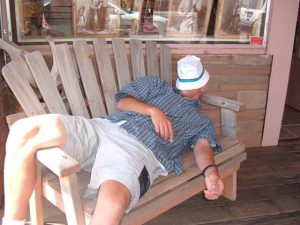 Fear of Injury
Fear of Injury
When we render our bodies unfit and incompetent, developing a fear of injury is natural. Fear of falling, getting hurt, and general safety are among the most commonly reported barriers to exercise.
Inertia
Many older adults report general apathy or laziness as a reason for not exercising. Some find exercise itself to be boring and others just lack the energy or motivation.
Depression and Anxiety
Older adults are dealing with more than just changes in body competency and mental sharpness – they may also be adjusting to the passing of loved ones, retirement, and having to care for frail persons older than themselves. Depression can have a huge impact on ones motivation to exercise.
Self-conscious
Older adults consider the worst part of aging to be the changes that occur to their physical appearance. Poor body image makes them fear exercising in gyms or other public areas.
Health Problems
Chronic illness, disability, joint pain, etc., are common health problems that can keep older adults from exercising. They may fear pain, further injury or sickness, or simply assume that they can’t physically do the work.
Lack of Knowledge
Many minority groups report that they don’t know how to exercise without instruction. There’s also a belief that exercise has to be very strenuous and uncomfortable for it to be effective, keeping some older adults from even considering exercising.
Ironically, Exercise is the Remedy
What’s ironic is that exercising could improve or reverse the conditions that keep older adults from exercising in the first place (i.e., fear of falling, anxiety, depression, poor body competence, etc.). Older adults have reported improvements in productivity, self-esteem, mood, and overall health with increased physical activity.
Exercising has also been shown to reduce the risk of falling and developing chronic conditions, such as heart disease, diabetes, cancer, and osteoporosis. It improves quality of life in people who are in poor health or disabled, increases confidence, and reduces levels of anxiety and depression.
Building a balanced exercise plan
Staying active is not a science. Just remember that mixing different types of physical activity helps both to keep your workouts interesting and improve your overall health. You can check out my list of free exercise videos for seniors. The key is to find activities that you enjoy—based on the four building blocks of fitness. These are:
1: Balance
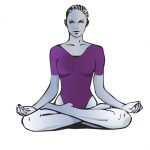
Maintains standing and stability, whether you’re stationary or moving around. Try yoga, Tai Chi, and posture exercises to gain confidence with balance. These exercises will help you improve your balance, posture, and quality of your walking. Also reduces risk of falling and fear of falls.
2: Cardio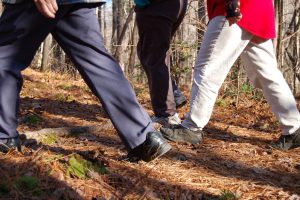
This type of exercise uses large muscle groups in rhythmic motions over a period of time. Cardio workouts get your heart pumping and you may even feel a little short of breath. Includes walking, stair climbing, swimming, hiking, cycling, rowing, tennis, and dancing.
These exercises help lessen fatigue and shortness of breath. Promotes independence by improving endurance for daily activities such as walking, house cleaning, and errands.
3: Strength and power training
These exercises build up muscle with repetitive motion using weight or external resistance from body weight, 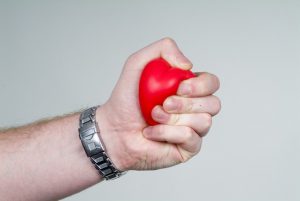 machines, free weights, or elastic bands. Power training is often strength training done at a faster speed to increase power and reaction times.
machines, free weights, or elastic bands. Power training is often strength training done at a faster speed to increase power and reaction times.
Strength training helps prevent loss of bone mass, builds muscle, and improves balance—both important in staying active and avoiding falls. Power training can improve your speed while crossing the street, for example, or prevent falls by enabling you to react quickly if you start to trip or lose balance.
Building strength and power will help you stay independent and make day-to-day activities easier such as opening a jar, getting in and out of a car, and lifting objects.
4: Flexibility
These exercises challenge the ability of your body’s joints to move freely through a full range of motion. This can be done through stationary stretches and stretches that involve movement to keep your muscles and joints supple and less prone to injury.
Yoga is an excellent means of improving flexibility. These exercises help your body stay limber and increases your range of movement for ordinary physical activities such as looking behind while driving, tying your shoes, shampooing your hair, and playing with your grandchildren.
Types of activities beneficial to older adults:
Walking – Walking is a perfect way to start exercising. It requires no special equipment, aside from a pair of comfortable walking shoes, and can be done anywhere.
Senior sports or fitness classes. Keeps you motivated while also providing a source of fun, stress relief, and a place to meet friends.
Water aerobics and water sports. Working out in water reduces stress and strain on the body’s joints.
Yoga. Combines a series of poses with breathing. Moving through the poses works on strength, flexibility and balance, and can be adapted to any level.
Tai Chi and Qi Gong. Martial arts-inspired systems of movement that increase balance and strength. Classes for seniors are often available at local YMCA or community centers.
What is your plan to stay active?
Recommended For You
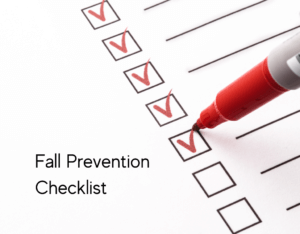
Fall Prevention Checklist For Seniors – Free Download
As we age, maintaining our balance and mobility becomes increasingly challenging. Falls can lead to serious injuries and a significant loss of independence. However, many falls are preventable with the …
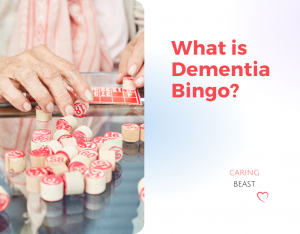
What is Dementia Bingo?
Bingo is a popular and fun activity for many people but it can be extremely overwhelming for someone with dementia or Alzheimer’s. Fortunately, there is a simplified version of this …

Free Financial Help For Seniors
After I sold my home care agency, I became Chief Operating Officer for a senior center in a small town in southern California. Every day I see seniors struggling to …

Drive Medical Nitro Euro Style Rollator Walker Review – It’s Red Hot!
Maybe you are like me, and just HATING the idea of using a friggin “walker”…I know I was, still am. There is no way I want to be creeping along …

POLST Forms For California
A POLST (Physician Orders for Life-Sustaining Treatment) form is a medical order designed to communicate a patient’s preferences regarding life-sustaining treatments in California. It is intended for individuals with serious …
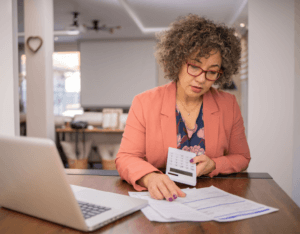
Caregiver IRS Tax Rules – A Guide for Caregivers
Caring for a loved one or working as a professional caregiver involves numerous responsibilities, including understanding the relevant tax implications. The IRS has specific rules that can affect caregivers, whether …

